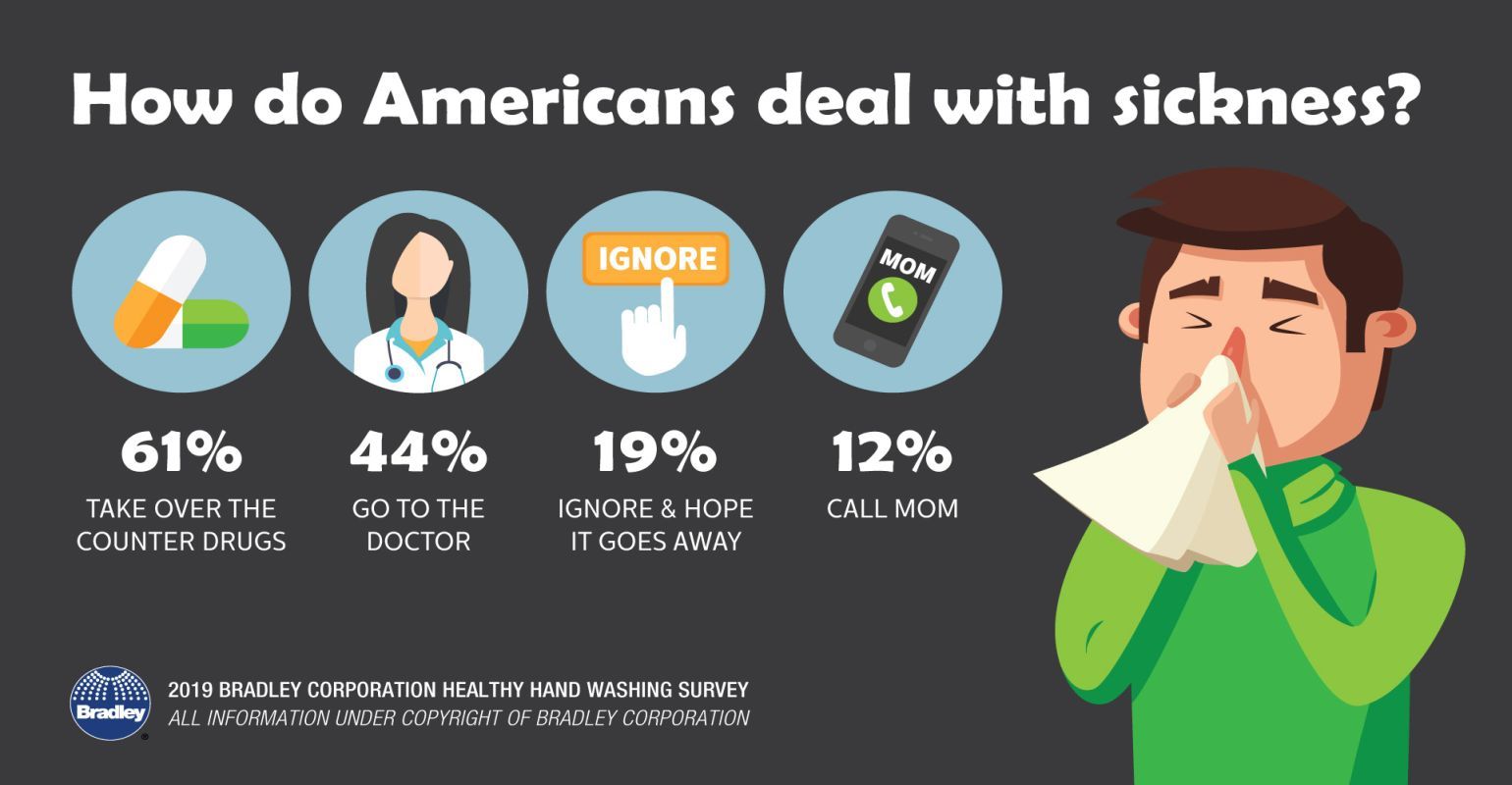Bradley Corp. Releases Results of 10th Annual Healthy Handwashing Survey

In the midst of this year’s flu season, Americans are taking preventive measures into their own hands. Three out of four say they step up their hand hygiene in response to viral outbreaks. Specifically, they wash more frequently, more thoroughly or longer, according to a national survey conducted by Bradley Corporation. That’s good news because the Centers for Disease Control and Prevention (CDC) says handwashing is the easiest and most effective defense against illness.
The survey also found that half of adults make a conscious effort to drink more fluids to reduce their likelihood of catching a cold or the flu. A good number rely on vitamin C or a zinc supplement as a preventive measure while others avoid touching their face, mouth and nose. Unfortunately, in today’s 24/7 environment, just one out of three get more sleep to try and fend off illness.
The findings are part of the 10th annual Healthy Handwashing Survey that queried 1,264 adults throughout the United States Jan. 3-8, 2019.
When Americans are feeling ill, nearly two out of three use over-the-counter medicine as their go-to remedy. A second group visits the doctor and a small number call their mom or conduct a virtual or online doctor visit. Approximately one out of five say they actually prefer to ignore their illness and hope it goes away. It may not be a surprise but men were significantly more likely to ignore their illness than women.
The survey revealed that sick Americans are considerate. More than half stay home to avoid passing their germs onto others. They also wash their hands more frequently, use antibacterial soap whenever possible, sneeze into the crook of their elbow and avoid shaking hands.
In terms of a preferred hand-cleaning method, nearly 2 out of 3 Americans believe their hands are less germy after washing with soap and water than after using hand sanitizer â a fact the CDC supports unequivocally.
According to the CDC, while hand sanitizer can be beneficial, washing with soap and water is the best way to reduce the number of germs. And, the CDC says it’s important to know that hand sanitizers are not effective when hands are visibly dirty.
“The proper way to wash is to use clean water and soap. Rub your hands together and scrub front, back and in between your fingers for at least 20 seconds. Finally, rinse and dry,” says medical microbiologist Michael P. McCann, PhD, professor of biology at Saint Joseph's University. “Thorough hand washing with a scrubbing motion is highly effective in removing bacteria, viruses and other disease-causing microorganisms from the surface of the skin.”
Bradley Corp. fielded its first Healthy Handwashing Survey in July 2009 at a time when the H1N1 virus was a national concern. Back then, just 45 percent of Americans said they elevated their hand hygiene in response to virus outbreaks. Today, that number has jumped to 73 percentwho do a better job of washing up when there’s a significant virus going around.
A statistic that has remained relatively unchanged over the years is the fact that, then and now, Americans report washing their hands 87 percent of the time after using a public restroom. For the instances when they didn’t wash, the reasons cited include sinks that weren’t working or were unclean or a lack of soap or paper towels.
Another interesting finding is the fact that women outperform men in hand hygiene. The survey has consistently revealed that men are more likely to skip the soap and simply rinse their hands after using a public restroom. In addition, men frequently report seeing others leave the restroom without washing their hands.
Surprisingly, it’s men who seem to respond to posted hand washing reminders more than women. In 2017 when the question was first posed, 44 percent of men said they were more likely to wash their hands after seeing a sign that requires employees to wash before returning to work compared to 34 percent of women.
“For the past 10 years, Americans have demonstrated they believe washing their hands after using a public restroom is very important,” says Jon Dommisse, director of strategy and corporate development for Bradley Corp. "However, their actual handwashing follow-through appears to fluctuate depending on the prevalence and severity of flu outbreaks. Our intention for conducting this survey is to elevate awareness of the effectiveness of washing with soap and water, and help make diligent hand washing a health necessity year-round."
The 10th annual survey queried 1,264 American adults online Jan. 3-9, 2019, about their hand washing habits in public restrooms and concerns about germs, colds and the flu. Participants were from around the country, were 18 years and older, and were fairly evenly split between men and women (49 and 51 percent).
Source: Bradley Corp.
Point-of-Care Engagement in Long-Term Care Decreasing Infections
November 26th 2024Get Well’s digital patient engagement platform decreases hospital-acquired infection rates by 31%, improves patient education, and fosters involvement in personalized care plans through real-time interaction tools.
The Leapfrog Group and the Positive Effect on Hospital Hand Hygiene
November 21st 2024The Leapfrog Group enhances hospital safety by publicizing hand hygiene performance, improving patient safety outcomes, and significantly reducing health care-associated infections through transparent standards and monitoring initiatives.
The Importance of Hand Hygiene in Clostridioides difficile Reduction
November 18th 2024Clostridioides difficile infections burden US healthcare. Electronic Hand Hygiene Monitoring (EHHMS) systems remind for soap and water. This study evaluates EHHMS effectiveness by comparing C difficile cases in 10 hospitals with CMS data, linking EHHMS use to reduced cases.